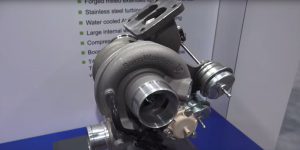One of the main setbacks in scaling different turbochargers for diesel, petrol, and gas engines is the inherit variability that different turbochargers would exhibit at low or high RPMs. In order to understand this further, a common term used to describe a flow characteristic of these machines is the A/R ratio. Technically, this ratio is defined as the inlet cross-sectional area divided by the radius from the turbo center to the centroid of that area (Figure 1). This ratio is essentially a metric for the amount of air that is allowed into the turbine section of the turbocharger.

For smaller turbochargers, lower A/R ratios allow the fast exhaust velocities to drive the turbine at lower speeds. This results in a more responsive engine and overall higher boosts at lower RPMs. However, once a vehicle starts to navigate at a higher RPM, smaller turbochargers experience a significant reduction in performance due to the high backpressure present in the system. This occurs because of the low A/R ratio limits the flow capacity and does not allow a sufficient amount of air to feed into the turbine. The same effect is present for larger turbochargers, only in reverse. They will perform most efficiently at higher RPMs, but in turn exhibit a significant reduction in performance at lower RPMs.
In order to overcome this phenomenon, many engineers have developed more complex turbocharger systems over the years, which attempt to leverage the benefits of each type of turbo. One of the first solutions to this dilemma was the twin turbo: simply comprised of two separate turbochargers operating in the system in parallel or in series. The problem with this system is that it disproportionately increases the cost, complexity, and space necessary for implementation.
Other technologies are very common for overcoming this problem without the use of two separate turbos. One design is the twin-scroll turbocharger, which works like a pair of turbochargers connected in parallel. Instead of using two separately sized turbochargers, the twin-scroll design has two exhaust-gas inlets and two nozzles feeding into a single turbocharger. Another design, the variable geometry turbocharger, uses internal vanes within the turbocharger to dynamically alter the A/R ratio of the system at different rev levels. The variable geometry turbocharger (VGT) displays exceptional performance at the low and high RPM ranges, however, it requires the use several moving parts and exotic materials in order to handle the high exhaust temperatures present in petroleum engines. For this reason, the variable geometry turbocharger is generally only used in diesel engines due to the relatively low exhaust temperatures in comparison. Twin-scroll turbochargers, while more commonly used in gasoline applications, do not have the variability of the VGT and are not as efficient over the full rev range of the vehicle.

BorgWarner has recently showcased a new turbocharger concept that makes use of both technologies discussed above. The “Twin-Scroll Variable Geometry Turbocharger” has a valve that can redirect airflow from just a single scroll to an airflow completely split between two scrolls. It allows for the any range in between these extremes much like the VGT; however, it only uses only one valve as opposed to the several vanes needed in the VGT. It derives the same exhaust separation idea as the twin-scroll while allowing for the variability of the VGT. With all the new emissions regulations calling for increases in efficiency, it will be interesting to see if this new technology can find its way into the market.
References:
http://www.economist.com/news/science-and-technology/21638917-why-turbocharged-four-cylinder-engines-now-rule-road-little-engine-could
https://www.carthrottle.com/post/engineering-explained-6-different-types-of-turbocharger-and-the-advantages-of-each-setup/














Here is an alternative already in the field on everything from Harley Davidson motorcycles to class 8 C15 Acerts, series 60 Detroits and ISX Cummins. Drivers are reporting from 1.25 mpg increases to 2.1 mpg increases with lower back pressure and egt’s. One vane and very simple.